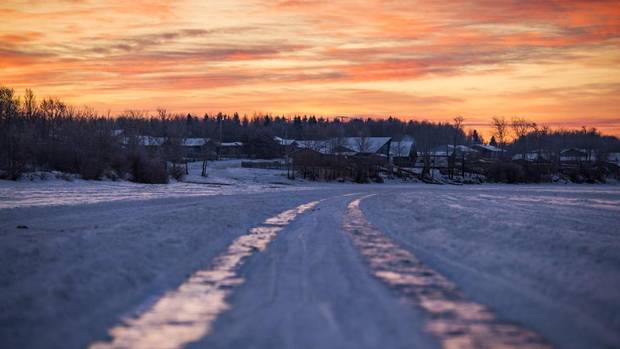Fires at the cemetery burned for days, flames rising from the frozen Saskatchewan ground where far too many of the town's youth are buried. Grieving relatives tended to the blazes, working to warm the soil and make way for graves.
La Loche, a northern town set on a lake at the end of a highway, will begin burying its latest victims of tragedy on Saturday, eight days after gunfire rang out at a local residence and at the village's only high school.
The day had begun like any other, with people heading off to work. Children filed into the La Loche Community School, a place that many here described as a beacon of hope. It was about to become a crime scene.
After killing two brothers at their grandparents' yellow home nearby, a gunman stormed the school, killing two people, injuring seven others and bringing terror to the halls. News of the mass killing – one of the worst school shootings in Canadian history – ricocheted through the village and beyond so quickly that there was confusion around the number of dead.
At a hastily called news conference at the World Economic Forum in Switzerland, Prime Minister Justin Trudeau said five were dead. In fact, four people, all under the age of 35, had lost their lives.
Marie Janvier, a 21-year-old teacher's aide who had a bright smile and her sights set on university, will be laid to rest in the cemetery Saturday. The two brothers – 13-year-old Drayden and 17-year-old Dayne Fontaine – will be buried Tuesday. Adam Wood, a 35-year-old teacher and outdoorsman who had just started at the school in September, will be laid to rest in his home province of Ontario.
A 17-year-old has been charged with four counts of first-degree murder and seven counts of attempted murder. The accused, who cannot be named under the Youth Criminal Justice Act, will be held in custody until his next court date on Feb. 22. The allegations have not been tested in court. Community members said the young man was bullied, reportedly about his ears. The Saskatoon StarPhoenix reported that he spared several students, including one to whom he said, "Oh no, not you, bro."
On Friday, one week after the shooting, Mr. Trudeau visited the predominantly indigenous village of about 2,600 people. He met with victims' families and some of the injured, and held a townhall meeting with hundreds of residents. "We will always denounce terrible acts of violence such as these, but we must remember this tragedy will not, must not, change who we are as individuals, who you are as members of a strong community," he said at a news conference. "The tragedy that this community went through should serve to highlight challenges that don't just exist here, but across the country."
The Prime Minister did not commit to a 10-year funding request from the mayor, though he assured the community that the government would offer support for years to come. He also said past governments, of all stripes, have not done enough for aboriginal people in this country.
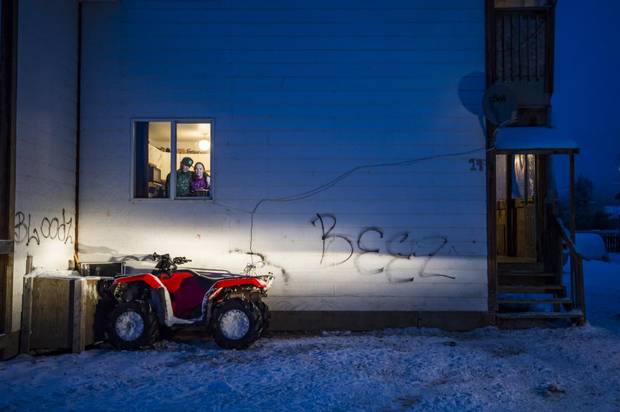
Nora Piche and her son Nathan at home on the Clearwater River Dene Nation, just a few kilometres north of La Loche.
John Lehmann/The Globe and Mail
La Loche rarely makes provincial or national headlines, but when it does, there tends to be violence, fires or suicide attached to the story. People here have been dying by suicide at an alarming rate for years. In the community centre, there are photos of deceased young men and women on a suicide-prevention poster; six faces are from last year alone. The crime rate is about eight times the provincial average. Access to mental-health services and addictions treatment is limited and unpredictable. Jobs are scarce. To make matters worse, residents last year were forced to evacuate amid unprecedented wildfires in the region.
This is not the only La Loche. The Globe and Mail has spoken with dozens of community members and local leaders, including many who say their hometown is being unfairly portrayed as a hopeless place where only terrible things happen. The violent crime rate has dropped 50 per cent over the past decade. Millions of provincial dollars have been put toward addressing the housing shortage, with 11 rental units currently under construction. Bingo money and corporate contributions are funding the construction of a much-anticipated youth centre. People are connected to their culture, speaking Dene and trapping. They take care of one another.
"This is our hometown – we have to get through this and it is going to take time, not just overnight," said Sandra Janvier, whose family has been preparing food for victims' families. "We have been through a lot of tragedies, and we have to take it one day at a time."
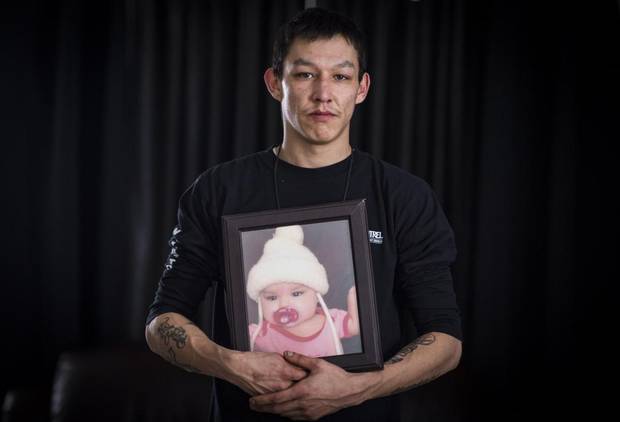
Nathan Piche holds a photo of his daughter Kiera at the Clearwater River Dene Nation in La Loche, Saskatchewan January 27, 2016. Nathan has been unable to see his daughter because his estranged from the the babies mother.
John Lehmann/The Globe and Mail
'A Canadian tragedy'
For many Canadians, La Loche – and the North generally – is a far-off place that is home to people they will never meet. But these days, as the country confronts its past and its relationship with indigenous peoples, the future of La Loche and communities facing similar challenges will put into stark focus Canada's journey toward reconciliation.
The relationship has been fraught, from colonialism to the Indian Residential School system and today's child-welfare system. Earlier this week, the Canadian Human Rights Tribunal ruled that the federal government discriminated against tens of thousands of vulnerable First Nations children by providing less money for welfare services on reserves than is available elsewhere in the country.
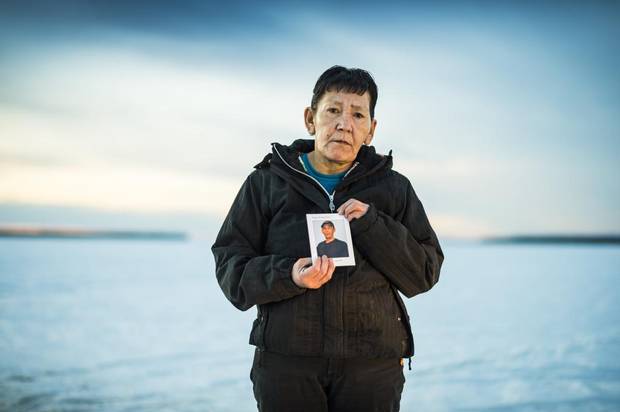
Rose Montgrand stands on Lac La Loche in La Loche, Saskatchewan January 27, 2016 holding a photo of her son Devin who committed suicide last September. There are times she forgets he is gone. “I hear someone come in the door and I think it might be him,” she said. “Sometimes, I even say his name.”
John Lehmann/The Globe and Mail
But some indigenous leaders and politicians say there is more hope now than ever, that better days are ahead. More indigenous voters turned out to last year's federal election than ever before, a signal of an increasing willingness to participate in a Canadian democratic system that some had viewed as antithetical to their sovereign identity. The Truth and Reconciliation Commission released its final report into the horrors faced by thousands of aboriginals in the residential-school system. The Prime Minister has promised to implement all of its recommendation. After decades of pleas from victims' families, Ottawa is moving forward with a national inquiry into Canada's missing and murdered indigenous women.
And then there are the rest of Mr. Trudeau's promises. He has said the time is nigh for a "nation-to-nation" relationship based on collaboration and respect.
For Wab Kinew, a prominent indigenous advocate, what happens next in La Loche – and the way Canadians have a conversation about it – will lay bare this country's progress in that regard. "The test of how far we've come, in terms of reconciliation, is do we see this merely as a northern tragedy," he asked, "or do we appreciate this for what it is, a Canadian tragedy?"
There are other difficult questions. How can La Loche, which is not a reserve but has close ties to nearby Clearwater Dene First Nation, build a brighter future for the children who survived the Jan. 22 attack? What can the provincial and federal governments do better, both there and in other indigenous communities? As a Prime Minister's Office spokesman told The Globe by e-mail, the "current system in place is neither meeting the needs – nor providing the sustained, predictable and sufficient funding necessary – for First Nations communities."
Mr. Kinew believes the federal and provincial governments should listen to the people of La Loche about what they need to survive and thrive. "If we're serious about this rhetoric of reconciliation, then the era of outsiders imposing solutions in northern communities should be over."
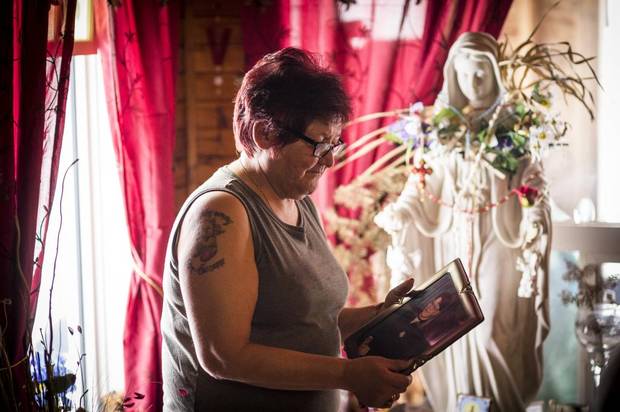
Last week’s tragedy brought back heartbreaking memories for Evangeline Lemaigreat of her own tragic loss: the death of her youngest son Evan nearly a decade ago, who was killed by a drunk driver
John Lehmann/The Globe and Mail
'That's a real gun'
The series of messages came in to a group chat around 1 p.m. on Jan. 22. The writer said he was "done with life." He went on: "just killed 2 ppl," "bout to shoot ip the school," "Dayne and lul … are dead." Lul was Drayden's nickname.
Student Noel Desjarlais-Thomas, 16, said he was just coming back from lunch when the shooter started firing bullets. His friends, more aware of what was going on, dashed by, yelling, "'Run, bro, run!'" he recalled. "'There's a shotgun! There's a shotgun!' They were just yelling to me. And then I was hearing those shots, too, so of course I started running."
There were about 150 students and teachers in the school. Some fled. Others hid, including in the gym's dressing room. One school employee, who was wounded and cannot be named because of a court-ordered publication ban, described the terror she witnessed to a TC Media reporter.
"I saw a male student go down and wondered what was going on," she said. "I started to move toward him and the gunman turned and fired another shot. I didn't think the gun was real until I saw the spark of it firing and then it was, 'Oh my God, this is real, it's not TV, that's a real gun.' Then it was 'What do I do?'" She was shot, the outlet reported, but made her way to a phone to call police.
Hers was one of many calls that came in to the RCMP, who arrived at the school on the town's main drag to see gunshot holes in the front door. At that point, they did not know about the dead brothers on Dene Crescent, in a part of La Loche known as Other Village. The RCMP believes the gunman ran through the school, shooting, for about eight or nine minutes before officers arrived. Following a short chase through the hallways, the suspect was arrested.
"The accused who was involved in the shooting was a surprise to everyone," said Clearwater's chief, Teddy Clark. "He was a good kid. It's one of those, 'Who would think?' moments."
Ms. Janvier and Mr. Wood were fatally shot, and seven others were wounded. As of mid-week, four were still in care at a Saskatoon hospital, but a provincial health official declined to release information about their conditions, citing the publication ban and privacy concerns.
Gone is Drayden Fontaine, who liked to ride snowmobiles and throw snowballs, and his older brother Dayne, who taught people how to snare animals and speak Dene. In a Facebook post, their mother said her heart "shattered into a million pieces."
Dead, too, is Ms. Janvier, whose loved ones jokingly likened her to a grandmother. "Marie had an old soul, from a very young age she possessed a spirit full of love and compassion for all people and animals," her obituary reads. "Marie, we know you would want us to focus on the positives and to be good to each other, this we will do in your memory."
Mr. Wood's family is grieving, too. Cars lined the street outside his childhood home in Uxbridge, Ont., last weekend. His loved ones described him as an adventurer, a seasoned outdoorsman and farmer who lived to push his own limits. In a statement, his family urged against coming up with "outsider opinions" about what led to the tragedy.
"Rather than looking for someone to blame, or coming up with outsider opinions of reasons why this occurred, we must stop and listen to the voices of La Loche," the statement said. "The leaders and members of the community know what types of support and changes are needed. Our responsibility as a nation is to listen and respond to create lasting systemic change."
At one of the La Loche gatherings, Perry Herman, who knew the suspect, called on the community to pay more attention to bullying, saying victims may be afraid to speak out. Other residents cautioned against drawing any conclusions about the motivation or background of the accused, saying it was more important to focus on helping the families involved.
Residents have raised money for the victims' loved ones. They helped maintain the cemetery fires. They lined the highway as Ms. Janvier's body was brought back to La Loche from Saskatoon.
"People are helping each other, no matter if we are relations or not," said Evangeline Lemaigre, whose daughter-in-law is a teacher's aide and witnessed the shooting. She hopes the woman will get the help she needs to work through the terror she experienced. She was reminded of her own pain after learning her 27-year-old son had died in a traffic accident about a decade ago.
Nearly everyone in La Loche has been touched by death related to substance abuse, violence or suicide. One of the six photos on the suicide-prevention poster in the community centre is that of Devin Montgrand, who died Sept. 29, 2015. He ended his life shortly before his 39th birthday. His cousin, Ryan Montgrand, had died by suicide earlier the same month.
Devin's mother, Rose Montgrand, has trouble sleeping. There are times she forgets he is gone. "I hear someone come in the door and I think it might be him," she said. "Sometimes, I even say his name."
The suicide rate in the health authority that encompasses La Loche was 43.4 per 100,000 people between 2008 and 2012. That is more than three times the overall provincial rate.
The town is part of the sprawling Keewatin Yatthé Regional Health Authority, which delivers services to about 12,000 people and has a total of 13 mental-health and addictions specialists. Of those specialists, the provincial Health Ministry says five are based in La Loche. Four of them will see local patients, as well as those who come in from elsewhere in the region, and the other routinely travels to other communities.
NDP health critic Danielle Chartier said the services are insufficient, especially given the suicide rate. "Whether you live in southern Saskatchewan or in the farthest corners of the North, you still deserve access to quality health care," she said. "The onus should be on the government – and is on the government – to ensure that its citizens are well-served. And that's just not the case."
A government-funded position for a child-and-family emergency duty worker in La Loche has been unfilled since September, leaving open a job created to investigate cases of abuse and help families in need of assistance in the isolated town. It is an on-call position, requiring someone in the community to be available weekday nights and weekends, for a salary that tops out at $27.45 an hour.
Gaps in health and social services have been "well-known and studied for many years," said Bobby Cameron, who heads the 74-member Federation of Saskatchewan Indian Nations. "This is nothing new. The pleas for help have been consistent."
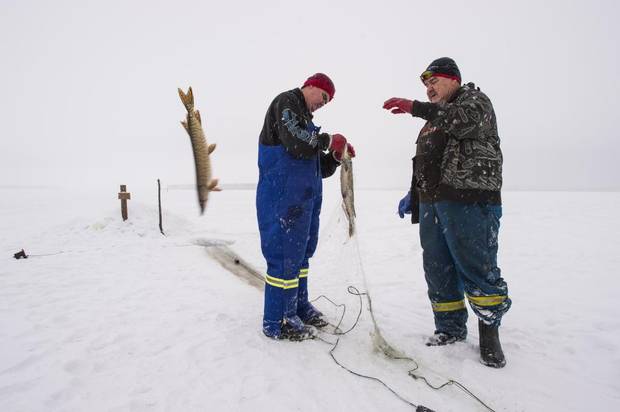
John Janvier, right, and his son Alden will take their catch to the family’s backyard smokehouse, where Sandra Janvier, Mr. Janvier’s wife, will clean them and prepared them for the families of the victims of last week’s school shooting.
John Lehmann/The Globe and Mail)
One recent foggy morning, John Janvier and his son hauled whitefish, jackfish and suckers from a hole in the ice covering Lac La Loche. They brought their catch to the family's backyard smokehouse, where Sandra Janvier, Mr. Janvier's wife, cleaned the fish so she could prepare meals for the victims' families.
There is a deep connection to the land and water here in La Loche, which was once a trading post. European settlement around the town dates back to the fur trade and the Methye Portage, a 20-kilometre trail between Lac La Loche and the Clearwater River. Indigenous guides showed the route, which connects the Hudson Bay and Arctic Ocean drainage systems, to trader Peter Pond in 1778. Others followed. The portage remained a key link until 1883, when steamboats started running on the Athabasca River near Edmonton.
Also in the 1800s, Beauval Indian Residential School was opened, about 300 kilometres southeast of La Loche. The school was at times overcrowded and brought other safety risks. One inspection in 1952 found fire escape doors opened inwards and were locked shut, the Truth and Reconciliation report says.
Mabel Fontaine was among the La Loche residents who were flown to the school. Ms. Fontaine, who spent eight years at Beauval, said she was physically abused by nuns and sexually assaulted by a priest. She was pregnant at 15 and spent years in an abusive relationship. Like others in the town, she turned to alcohol.
She has been sober for years, left the abusive relationship and lives on Clearwater reserve. She took a cooking program through Northlands College and put her skills to use last week helping feed out-of-towners, including crisis counselors. There are social problems in La Loche, she concedes, but there is also optimism and resilience. "La Loche is my home, it's a good place," she said. "Bad things happen here, but bad things happen all over the place. Shootings, killings, murders – those don't just happen in La Loche. They happen everywhere."
Ottawa has provided community-based organizations in La Loche with millions in funding to help stem the violence. Status of Women, for example, provided $260,000 for a project to address violence against indigenous women and girls. That ended in 2015, as did another federally supported initiative, called Project Venture. With more than $1-million in funding over five years, the youth-development program served hundreds of children in the community. Drayden was among those who participated.
Cheyanne Lemaigre, a 25-year-old Dene woman who grew up in La Loche, lost her job as a youth worker after the program wound down last summer. She said she believes the program, which involved consistent in-class, after-school and weekend programming, was making a difference for youth in the community and said the children were sad to see it end. Public Safety is currently funding another five-year, $2.6-million project geared toward youth and their parents. Ms. Lemaigre, for her part, is collecting employment insurance while she searches for work in La Loche or elsewhere.
Some residents work in Saskatchewan's northern uranium mines or in the oil sands in neighbouring Alberta, although plans for a highway connecting La Loche to Fort McMurray – a project that would have helped alleviate the unemployment problem – fizzled earlier this decade. A rough ice road connects the communities during winter months, but for the rest of the year, it is a 10-hour drive.
The head of the La Loche Friendship Centre said many positions in the community – probation officers and mental-health workers, for example – are filled by people from out of town. "We can't find people in our community with the proper skills and the education to do these programs," he said, adding that better training programs are critical. The latter are scarce, he said, pointing to a recent federally funded heavy-equipment operator training program that drew more than 100 applications for just eight spots.
When various socio-economic factors are taken together, including labour-force activity, both La Loche and Clearwater River Dene Nation score toward the bottom of the federal community well-being index. In 2011 – the latest assessment year – the median score among 3,329 indigenous and non-indigenous communities was 78. Clearwater scored 42. La Loche was given a 48.
Mr. Trudeau has promised to end all boil-water advisories in First Nations communities within five years. Of the 136 advisories across the country as of November of last year, 92 are First Nations communities. Clearwater River Dene Nation is among them. The Prime Minister's promise, then, extends to the roughly 900 people who live on the reserve, who are also confronting a housing shortage, the chief said. Indigenous Affairs Canada has provided $82.6-million over the past decade, including $18.3-million for community infrastructure, which includes housing.
But as La Loche residents will point out, numbers do not tell the whole story. Yes, the high school has been frequently ranked among the worst in the province. One think tank in 2011 ranked the La Loche Community School 169th out of 170 schools in Saskatchewan. And yet many here see the school as a nurturing place for youth to gather. "The school has been a safe haven for a lot of our children," said Mr. Clark, the chief. Ms. Lemaigre, of Project Venture, said there were times she connected struggling youth with the social worker at the school, where they also held some of their programming.
The school, built in 1974 and renovated in 2006, is home to the Lakers, including boys' and girls' volleyball and basketball teams that compete in provincial leagues and travel hundreds of kilometres to do so. Despite losing Ms. Janvier to violence at the school, her family still wants donations sent there in lieu of flowers.
Classes are expected to resume in La Loche in the second week of February. The provincial government has said it is looking at adding a security position at the school, while acting mayor Kevin Janvier wants the school to start over, from the ground up. "Personally, I want the school rebuilt … because of the trauma that happened," Mr. Janvier said.
In a letter to students on the school's Facebook page Friday, teachers vowed to carry on. "Families are formed by blood and by circumstance," the message said. "We will be back. We will rebuild. We will get better together. So if you find yourself wondering where your teachers and school staff are, the answer is: we are in La Loche. Because truly, where else would we be?"
With reports from Justin Giovannetti, Rick Cash and The Canadian Press
